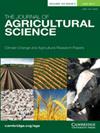Influence of Glufosinate Rate, Ammonium Sulfate, and Weed Height on Annual Broadleaf Weed Control
IF 2.2
4区 农林科学
Q2 AGRICULTURE, MULTIDISCIPLINARY
引用次数: 0
Abstract
Weed control efficacy with contact herbicides can depend on weed height at application. Four field experiments were conducted at sites with multiple weed species at different heights to determine the effect of weed height, glufosinate rate, and the addition of ammonium sulfate (AMS) on annual broadleaf weed control in soybean in southwestern Ontario, Canada, during 2021 and 2022. Glufosinate was applied at 300 or 500 g ai ha-1 without or with 6.50 L ha-1 of AMS to 5, 10, and 15 cm tall common lambsquarters (Chenopodium album L.), common ragweed (Ambrosia artemisiifolia L.), velvetleaf (Abutilon theophrasti Medik.), and redroot pigweed (Amaranthus retroflexus L.). Glufosinate provided excellent common ragweed control (> 98%) at both rates, without and with AMS, and at all three heights 4 weeks application (WAA). In contrast, glufosinate efficacy declined when applied to common lambsquarters, velvetleaf, and redroot pigweed > 5 cm in height. The addition of AMS to glufosinate improved common lambsquarters control. Increasing the rate of glufosinate to 500 g ai ha-1 and the addition of AMS improved control of velvetleaf and redroot pigweed. The results of this study demonstrate that the effect of glufosinate rate, AMS addition, and weed height at application timing is weed species-specific. In general, glufosinate (300 g ai ha-1) controlled common annual broadleaf weeds if weeds were < 5 cm in height; otherwise, glufosinate needed to be applied at 500 g ai ha-1 with AMS for control of annual broadleaf weeds, especially common lambsquarters, velvetleaf and redroot pigweed.草甘膦用量、硫酸铵和杂草高度对一年生阔叶杂草防治的影响
接触除草剂的除草效果取决于施用时的杂草高度。本研究于2021年和2022年在加拿大安大略省西南部进行了4个不同杂草高度、不同杂草种类的田间试验,研究了杂草高度、草铵膦用量和硫酸铵(AMS)对大豆阔叶杂草的防治效果。分别在5、10和15 cm高的普通羔羊(Chenopodium album L.)、普通豚草(Ambrosia artemisiifolia L.)、棉叶(Abutilon theophrasti Medik.)和重根藜草(Amaranthus retroflexus L.)上施用300或500 g草铵,不施用或添加6.50 L草铵(AMS)。草甘膦在施用4周的三个高度(WAA)下,在不施用和施用AMS的情况下,对豚草的控制效果都很好(> 98%)。草铵膦对身高大于5 cm的普通羔羊草、绒叶草和重根藜草的施用效果下降。在草铵膦中添加AMS改善了对普通羔羊的控制。将草铵膦施用量提高至500 g / hm -1,并添加AMS,可改善对丝叶和重根藜的控制。本研究结果表明,施用时草甘膦用量、AMS添加量和杂草高度的影响是杂草特有的。一般情况下,禾草膦(300 g / ha-1)对禾草高度< 5 cm的常见一年生阔叶杂草有控制作用;对一年生阔叶杂草,特别是常见的羊蹄草、绒叶草和重根藜,则需要在AMS中施用500 g / ha-1草铵膦。
本文章由计算机程序翻译,如有差异,请以英文原文为准。
求助全文
约1分钟内获得全文
求助全文
来源期刊

Journal of Agricultural Science
农林科学-农业综合
CiteScore
2.80
自引率
5.00%
发文量
68
审稿时长
1.4 months
期刊介绍:
The Journal of Agricultural Science publishes papers concerned with the advance of agriculture and the use of land resources throughout the world. It publishes original scientific work related to strategic and applied studies in all aspects of agricultural science and exploited species, as well as reviews of scientific topics of current agricultural relevance. Specific topics of interest include (but are not confined to): all aspects of crop and animal physiology, modelling of crop and animal systems, the scientific underpinning of agronomy and husbandry, animal welfare and behaviour, soil science, plant and animal product quality, plant and animal nutrition, engineering solutions, decision support systems, land use, environmental impacts of agriculture and forestry, impacts of climate change, rural biodiversity, experimental design and statistical analysis, and the application of new analytical and study methods (including genetic diversity and molecular biology approaches). The journal also publishes book reviews and letters. Occasional themed issues are published which have recently included centenary reviews, wheat papers and modelling animal systems.
 求助内容:
求助内容: 应助结果提醒方式:
应助结果提醒方式:


